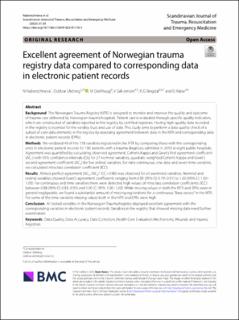| dc.contributor.author | Naberezhneva, Natalia | |
| dc.contributor.author | Uleberg, Oddvar | |
| dc.contributor.author | Dahlhaug, Marianne | |
| dc.contributor.author | Giil-Jensen, Vigdis | |
| dc.contributor.author | Ringdal, Kjetil G. | |
| dc.contributor.author | Røise, Olav | |
| dc.date.accessioned | 2024-03-06T14:48:24Z | |
| dc.date.available | 2024-03-06T14:48:24Z | |
| dc.date.created | 2023-10-03T09:58:48Z | |
| dc.date.issued | 2023 | |
| dc.identifier.issn | 1757-7241 | |
| dc.identifier.uri | https://hdl.handle.net/11250/3121325 | |
| dc.description.abstract | Background - The Norwegian Trauma Registry (NTR) is designed to monitor and improve the quality and outcome of trauma care delivered by Norwegian trauma hospitals. Patient care is evaluated through specific quality indicators, which are constructed of variables reported to the registry by certified registrars. Having high-quality data recorded in the registry is essential for the validity, trust and use of data. This study aims to perform a data quality check of a subset of core data elements in the registry by assessing agreement between data in the NTR and corresponding data in electronic patient records (EPRs).
Methods - We validated 49 of the 118 variables registered in the NTR by comparing those with the corresponding ones in electronic patient records for 180 patients with a trauma diagnosis admitted in 2019 at eight public hospitals. Agreement was quantified by calculating observed agreement, Cohen’s Kappa and Gwet’s first agreement coefficient (AC1) with 95% confidence intervals (CIs) for 27 nominal variables, quadratic weighted Cohen’s Kappa and Gwet’s second agreement coefficient (AC2) for five ordinal variables. For nine continuous, one date and seven time variables, we calculated intraclass correlation coefficient (ICC).
Results - Almost perfect agreement (AC1 /AC2/ ICC > 0.80) was observed for all examined variables. Nominal and ordinal variables showed Gwet’s agreement coefficients ranging from 0.85 (95% CI: 0.79–0.91) to 1.00 (95% CI: 1.00–1.00). For continuous and time variables there were detected high values of intraclass correlation coefficients (ICC) between 0.88 (95% CI: 0.83–0.91) and 1.00 (CI 95%: 1.00–1.00). While missing values in both the NTR and EPRs were in general negligeable, we found a substantial amount of missing registrations for a continuous “Base excess” in the NTR. For some of the time variables missing values both in the NTR and EPRs were high.
Conclusion - All tested variables in the Norwegian Trauma Registry displayed excellent agreement with the corresponding variables in electronic patient records. Variables in the registry that showed missing data need further examination. | en_US |
| dc.language.iso | eng | en_US |
| dc.publisher | BioMed Central (BMC) | en_US |
| dc.relation.uri | https://sjtrem.biomedcentral.com/articles/10.1186/s13049-023-01118-5 | |
| dc.rights | Navngivelse 4.0 Internasjonal | * |
| dc.rights.uri | http://creativecommons.org/licenses/by/4.0/deed.no | * |
| dc.title | Excellent agreement of Norwegian trauma registry data compared to corresponding data in electronic patient records | en_US |
| dc.title.alternative | Excellent agreement of Norwegian trauma registry data compared to corresponding data in electronic patient records | en_US |
| dc.type | Peer reviewed | en_US |
| dc.type | Journal article | en_US |
| dc.description.version | publishedVersion | en_US |
| dc.source.volume | 31 | en_US |
| dc.source.journal | Scandinavian Journal of Trauma, Resuscitation and Emergency Medicine | en_US |
| dc.source.issue | 1 | en_US |
| dc.identifier.doi | 10.1186/s13049-023-01118-5 | |
| dc.identifier.cristin | 2181194 | |
| cristin.ispublished | true | |
| cristin.fulltext | original | |
| cristin.qualitycode | 1 | |

